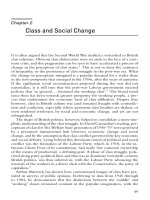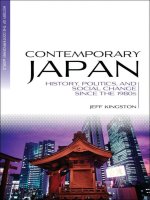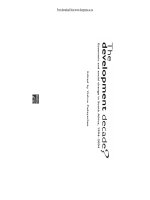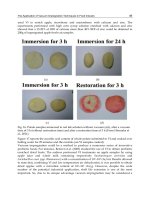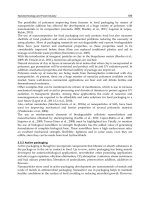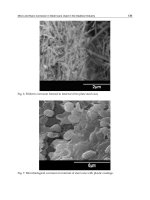contemporary japan history, politics, and social change since the 1980s
Bạn đang xem bản rút gọn của tài liệu. Xem và tải ngay bản đầy đủ của tài liệu tại đây (1.48 MB, 325 trang )
c01.indd 2c01.indd 2 5/25/2010 10:16:35 AM5/25/2010 10:16:35 AM
CONTEMPORARY
JAPAN
ffirs.indd iffirs.indd i 5/25/2010 10:17:29 AM5/25/2010 10:17:29 AM
A HISTORY OF THE CONTEMPORARY WORLD
General Editor: Keith Robbins
This series offers an historical perspective on the development of the
contemporary world. Each of the books examines a particular region
or a global theme as it has evolved in the recent past. The focus is
primarily on the period since the 1980s but authors provide deeper
context wherever necessary. While all the volumes offer an historical
framework for analysis, the books are written for an interdisciplinary
audience and assume no prior knowledge on the part of readers.
Published
Contemporary Japan
Jeff Kingston
In Preparation
Contemporary America
Michael Heale
Contemporary Latin America
Robert H Holden & Rina Villars
Contemporary South Asia
David Hall Matthews
Contemporary Africa
Tom Lodge
Contemporary China
Yongnian Zheng
ffirs.indd iiffirs.indd ii 5/25/2010 10:17:29 AM5/25/2010 10:17:29 AM
CONTEMPORARY
HISTORY, POLITICS, AND
SOCIAL CHANGE
SINCE THE 1980S
JEFF KINGSTON
JAPAN
A John Wiley & Sons, Ltd., Publication
ffirs.indd iiiffirs.indd iii 5/25/2010 10:17:29 AM5/25/2010 10:17:29 AM
This edition fi rst published 2011
© 2011 Jeff Kingston
Blackwell Publishing was acquired by John Wiley & Sons in February 2007. Blackwell’s
publishing program has been merged with Wiley’s global Scientifi c, Technical, and Medical
business to form Wiley-Blackwell.
Registered Offi ce
John Wiley & Sons Ltd, The Atrium, Southern Gate, Chichester, West Sussex, PO19 8SQ,
United Kingdom
Editorial Offi ces
350 Main Street, Malden, MA 02148-5020, USA
9600 Garsington Road, Oxford, OX4 2DQ, UK
The Atrium, Southern Gate, Chichester, West Sussex, PO19 8SQ, UK
For details of our global editorial offi ces, for customer services, and for information about how
to apply for permission to reuse the copyright material in this book please see our website at
www.wiley.com/wiley-blackwell.
The right of Jeff Kingston to be identifi ed as the author of this work has been asserted in
accordance with the UK Copyright, Designs and Patents Act 1988.
All rights reserved. No part of this publication may be reproduced, stored in a retrieval system,
or transmitted, in any form or by any means, electronic, mechanical, photocopying, recording
or otherwise, except as permitted by the UK Copyright, Designs and Patents Act 1988, without
the prior permission of the publisher.
Wiley also publishes its books in a variety of electronic formats. Some content that appears in
print may not be available in electronic books.
Designations used by companies to distinguish their products are often claimed as trademarks.
All brand names and product names used in this book are trade names, service marks,
trademarks or registered trademarks of their respective owners. The publisher is not associated
with any product or vendor mentioned in this book. This publication is designed to provide
accurate and authoritative information in regard to the subject matter covered. It is sold on the
understanding that the publisher is not engaged in rendering professional services. If
professional advice or other expert assistance is required, the services of a competent
professional should be sought.
Library of Congress Cataloging-in-Publication Data
Kingston, Jeff, 1957–
Contemporary Japan : history, politics and social change since the 1980s / Jeffrey Kingston.
p. cm. – (History of the contemporary world)
Includes bibliographical references and index.
ISBN 978-1-4051-9194-4 (hardcover : alk. paper) – ISBN 978-1-4051-9193-7
(pbk. : alk. paper) 1. Japan–History–Heisei period, 1989– 2. Japan–Social
conditions–1989– 3. Japan–Economic conditions–1989– I. Title.
DS891.K538 2011
952.04–dc22
2010009774
A catalogue record for this book is available from the British Library.
Set in 10.5/13 pt Minion by Toppan Best-set Premedia Limited
Printed in Malaysia
1 2011
ffirs.indd ivffirs.indd iv 5/25/2010 10:17:30 AM5/25/2010 10:17:30 AM
Map vii
Series Editor’s Preface viii
Acknowledgments x
Part I Introduction 1
1 Transformations After World War II 3
2 The Lost Decade 23
Part II Risk and Consequences 39
3 Defusing the Demographic Time Bomb 41
4 Families at Risk 66
5 Jobs at Risk 84
Part III Politics and Consequences 101
6 Contemporary Politics 103
7 Security and the Peace Constitution 124
8 Environmental Issues 145
9 Immigration 166
10 War Memory and Responsibility 185
Part IV Institutions at Risk 207
11 The Imperial Family 209
12 Yakuza 227
Contents
ftoc.indd vftoc.indd v 5/25/2010 10:17:38 AM5/25/2010 10:17:38 AM
vi
Contents
Part V Postscript 253
13 Prospects 255
Glossary 261
Notes 269
Further Reading 283
Index 291
ftoc.indd viftoc.indd vi 5/25/2010 10:17:39 AM5/25/2010 10:17:39 AM
R
Y
U
K
Y
U
I
S
L
A
N
D
S
CHINA
0
0 200
200
NORTH
KOREA
SOUTH
KOREA
Yellow
Sea
East
China
Sea
SENKAKU-
SHOTO
DAITO-
SHOTO
VOLCANO
ISLANDS
Philippine
Sea
NORTH
PACIFIC
OCEAN
Sea of
Japan
Dokdo/
Takeshima*
Tsugaru-
kaikyo
Sapporo
400 km
400 mi
RUS.
N
A
M
P
O
-
S
H
O
T
O
TOKYO
Hiroshima
Fukuoka
Kyushu
Shikoku
Osumi-
kaikyo
Okinawa
BONIN
ISLANDS
Sendai
Akita
Honshu
Yokohama
Nagoya
Osaka
Kobe
Kitakyushu
Korea
Stralt
Hokkaido
La Perouse Strait
Nagasaki
Map of Japan
* These are the Korean and Japanese names for this disputed territory
fbetw.indd viifbetw.indd vii 5/25/2010 10:17:26 AM5/25/2010 10:17:26 AM
Series Editor ’ s Preface
The contemporary world frequently presents a baffl ing spectacle: “ new
world orders ” come and go; “ clashes of civilizations ” seem imminent if not
actual; “ peace dividends ” appear easily to vanish into thin air; terrorism
and “ wars on terror ” occupy the headlines. “ Mature ” states live alongside
“ failed ” states in mutual apprehension. The “ rules ” of the international
game, in these circumstances, are diffi cult to discern. What “ international
law ” is, or is not, remains enduringly problematic. Certainly it is a world
in which there are still frontiers, borders, and boundaries, but both meta-
phorically and in reality they are diffi cult to patrol and maintain. “ Asylum ”
occupies the headlines as populations shift across continents, driven by
fear. Other migrants simply seek a better standard of living. The organs of
the “ international community, ” though frequently invoked, look inade-
quate to deal with the myriad problems confronting the world. Climate
change, however induced, is not susceptible to national control. Famine
seems endemic in certain countries. Population pressures threaten fi nite
resources. It is in this context that globalization, however understood, is
both demonized and lauded.
Such a list of contemporary problems could be amplifi ed in detail and
almost indefi nitely extended. It is a complex world, ripe for investigation
in this ambitious new series of books. “ Contemporary, ” of course, is always
diffi cult to defi ne. The focus in this series is on the evolution of the world
since the 1980s. As time passes, and as the volumes appear, it no longer
seems sensible to equate “ the world since 1945 ” with “ contemporary
history. ” The legacy of the “ Cold War ” lingers on but it is emphatically “ in
the background. ” The fuzziness about “ the 1980s ” is deliberate. No single
year ever carries the same signifi cance across the globe. Authors are
therefore establishing their own precise starting points, within the overall
“ contemporary ” framework.
fpref.indd viiifpref.indd viii 5/25/2010 10:17:35 AM5/25/2010 10:17:35 AM
Series Editor’s Preface
ix
The series treats the history of particular regions, countries, or conti-
nents but does so in full awareness that such histories, for all their continu-
ing distinctiveness, can only rarely be considered apart from the history of
the world as a whole. Economic, demographic, environmental, and reli-
gious issues transcend state, regional, or continental boundaries. Just as the
world itself struggles to reconcile diversity and individuality with unity and
common purpose, so do the authors of these volumes. The concept is chal-
lenging. Authors have been selected who sit loosely on their disciplinary
identity – whether that be as historians, political scientists, or students of
international relations. The task is to integrate as many aspects of contem-
porary life as possible in an accessible manner.
This volume on Japan rises to the challenge. The country ’ s history con-
spicuously illustrates the interactions that have been alluded to. The fi rst
half of the twentieth century saw its engagement with “ the world ” collapse
in catastrophe. The country started thereafter on its “ new beginning ”
under outside direction. Yet its proud and self - contained past still contin-
ued to send somewhat ambivalent messages into a Japan which proceeded
to make itself a “ modern miracle. ” This account, however, is no bland
narrative of a “ success story. ” It is, rather, an account of decades in which
the reconciliations – economic, cultural, demographic, political – which
appeared to have been solid achievements all began to unravel. It is this
process of renewed self - examination, visible across so many areas of both
private and public life, which this book treats as an interconnected whole.
There can be no better example, to begin this series, of a country seeking
anxiously both to adjust and to retain its own culture and identity in a
changing world.
Keith Robbins
fpref.indd ixfpref.indd ix 5/25/2010 10:17:36 AM5/25/2010 10:17:36 AM
Acknowledgments
I would like to thank the following people for their assistance, comments,
advice, inspiration and encouragement with all the usual caveats about
absolving them of responsibility for what I have written: Jake Adelstein,
Hideaki Asahi, Michael and Marie - Therese Barrett, Tom Boardman, Mary
Brinton, Roland Buerk, David Campbell, John Campbell, Christian Caryl,
Kyle Cleveland, Florian Coulmas, Lucy Craft, Gerald Curtis, Greg Davis,
Phil Deans, Mure Dickie, Alexis Dudden, Robert Dujarric, Bill Emmott,
Martin Fackler, Malcolm Foster, Howard French, John Glionna, Roger
Goodman, Mariko Hashioka, Laura Hein, Ektarina Hertog, Steve Hesse,
Peter Hill, Kaori Hitomi, Jun Honna, Andrew Horvat, Tin Tin Htun,
Hiroshi Ishida, Makoto Ishida, Velisarios Kattoulas, David Leheny, Bertil
Lintner, Atsushi Maki, Gavan McCormack, David McNeill, Johnny Miller,
Sebastian Moffett, Jack Mosher, Mariko Nagai, Chika Nakayama, Atsushi
Ogata, Akihiro Ogawa, Robert Orr, David Pilling, Lawrence Repeta, Donald
Richie, Ken Ruoff, Sven Saaler, Richard Samuels, Murray and Jenny Sayle,
Fritz Schmitz, Miki Seko, Mark Selden, Sawako Shirahase, David Slater,
Emi Sumitomo, Ayumi Suzuki, Yuki Tanaka, Kazuhiko Togo, Henry
Tricks, Gabrielle Vogt, Yoshibumi Wakamiya, Shinya Watanabe, Robert
Whiting, Charles Worthen, Hyun Sook Yun, Dominique Ziegler, and
many others who know who you are. Also I wish to express thanks to the
people at Wiley who took on this project and ensured its smooth sailing,
especially Tessa Harvey, Keith Robbins, Tom Bates, Gillian Kane, Sarah
Dancy, and Brian Goodale.
Finally, my deep gratitude to Machiko Osawa, who contributed greatly
to this book and, along with our dogs Rhubarb and Goro, listened patiently
and kept me in good spirits.
Please note that in Japan, Japanese names begin with the family name,
but here are cited according to Western convention: given name followed
by surname.
flast.indd xflast.indd x 5/25/2010 10:17:32 AM5/25/2010 10:17:32 AM
Part I
Introduction
c01.indd 1c01.indd 1 5/25/2010 10:16:34 AM5/25/2010 10:16:34 AM
c01.indd 2c01.indd 2 5/25/2010 10:16:35 AM5/25/2010 10:16:35 AM
Chapter 1
Transformations After
World War II
Japan ’ s recovery from the war devastation that left its cities and factories
in ruins was surprisingly rapid, but nobody in the late 1940s could have
foreseen that its economy would one day become the second largest in the
world. In the aftermath of defeat, Japanese experienced unprecedented
socio - economic upheaval during what has to be regarded as one of the
world ’ s great success stories in the second half of the twentieth century.
Japan was reconstituted during the US Occupation (1945 – 52), generated
an economic miracle in the late 1950s and 1960s, weathered the oil shocks
in the 1970s, and saw an extraordinary asset bubble burst at the end of the
1980s, setting the stage for the Lost Decade of the 1990s. This was a time
of one - party democracy under the Liberal Democratic Party (LDP) that
ruled Japan as a partner of the bureaucracy and big business in what is
known as Japan, Inc. or the Iron Triangle. It was also a time when the long
shadows of wartime deprivation and dislocation shaped a national consen-
sus prioritizing stability, security, and policies aimed at minimizing risk.
In post - WWII Japan, there was massive migration from rural areas to the
cities, pulled by the lure of jobs and pushed by the limited opportunities of
small - scale farming. The ensuing growth of cities, with housing develop-
ments, train lines, and highways, created a mass commuting culture with a
rhythm very distinct from traditional rural life. The salaryman lifestyle
became iconic, a way of life rooted in the breadwinner model, with a work -
driven husband, a full - time housewife, and at least two children, usually
living with some of their grandparents. Signs of growing affl uence became
more conspicuous in an expanding middle class. Women were nominally
freed from patriarchy with the abolition of the ie (patrilineal family) system,
and gained the right to vote and other constitutional guarantees, but in the
workforce they remained largely marginalized. The rapid growth of the
1960s did not generate large income disparities as was common in Western
c01.indd 3c01.indd 3 5/25/2010 10:16:35 AM5/25/2010 10:16:35 AM
4
Transformations After World War II
industrialized societies, and the relatively egalitarian distribution combined
with job security strengthened social cohesion and a sense of shared desti-
nies. This social capital remains one of the foundations and strengths of
post - WWII Japan, but is under threat due to widening income disparities.
The spread of mass media, especially television, helped nurture a strong
sense of nation even as overt displays of nationalism remained taboo,
tainted by war. Emperor Hirohito was transformed from a wartime leader
into an avuncular and soft - spoken symbol of the nation. Japan was visibly
welcomed back into the community of nations at the 1964 Tokyo Olympics,
a sign that it had been rehabilitated under the auspices of US hegemony.
While neighbors may have found the continuing presence of the US
military reassuring, Japanese remained divided and ambivalent about this
encroachment on their sovereignty. Mass demonstrations against renewal
of the US – Japan Security Treaty in 1960 revealed a surprising depth of
anger, not only directed against Washington. Prime Minister Nobusuke
Kishi, who negotiated the renewal, was a suspected Class - A war criminal,
one of those senior leaders deemed responsible for orchestrating Japan ’ s
military rampage through Asia 1931 – 45. He was never indicted, and was
released from prison for reasons that remain unclear given his culpable
record in Manchuria and later as the wartime Minister of Commerce
and Industry. Many Japanese, with the horrors of the war fresh in their
memories, deeply resented Kishi ’ s rise to premier through backroom politi-
cal maneuvering; he represented an unacceptable link to a thoroughly
discredited past. In those days, nobody was trying to glorify or justify
Japan ’ s wartime exploits as some do now, and anyone associated with
Japanese militarism was persona non grata , making it especially galling that
such a key fi gure in the wartime cabinet was suddenly the leader of a country
that was trying to reinvent itself by repudiating such continuities.
Occupation 1945 – 52
Allied in name, but an American show in practice, the Supreme Commander
of the Allied Powers (SCAP, a term often used to refer more generally to
the Occupation authorities) was personifi ed in the larger - than - life, domi-
nating presence of General Douglas MacArthur. General Headquarters
(GHQ), the administration under SCAP, governed indirectly through the
existing Japanese bureaucracy; this was a signifi cant contrast to the situa-
tion in a divided Germany where the Allied powers ruled directly.
c01.indd 4c01.indd 4 5/25/2010 10:16:35 AM5/25/2010 10:16:35 AM
Transformations After World War II
5
The US presided over Japan in the aftermath of war in order to demili-
tarize and democratize its former enemy.
1
SCAP acted on the perception
that the military had derailed democracy and hijacked the nation into war,
and that the high concentration of political and economic power made
Japan vulnerable to such a scenario. With Germany and the two world wars
it precipitated in mind, the US sought to inoculate Japan from a militarist
revival. Thus, SCAP focused on eliminating the military and dispersing
political and economic power more widely.
Demilitarizing Japan started with demobilizing the troops, confi scating
their weapons, and eliminating military institutions. This was followed up
by a ban on war, and the means to wage it, in Article 9 of the Constitution
authored by SCAP and adopted by Japan in 1947. Martial arts were also
banned and SCAP authorities censored the media and fi lms in clumsy
efforts to stifl e non - existent militaristic sentiments. People were war weary
and the military was widely blamed for the destruction and suffering the
Japanese people endured.
The war in the Pacifi c (1941 – 5), infl amed by racial prejudice and fears,
was a “ war without mercy. ”
2
Given the extent of excesses and atrocities
committed by Japan, the US, and its allies, the mutual accommodations
and relative benefi cence of the Occupation are striking. The arrival of the
Americans sparked fears of retribution, and soon after the surrender the
Japanese authorities were already recruiting women to provide sexual serv-
ices to the troops. Throughout the Occupation, American troops did
commit serious crimes against the civilian population, including murder,
rape, and assault, but not on the scale that many Japanese had feared,
knowing as they did how the Imperial Armed Forces operated in the ter-
ritories it occupied.
In late 1945 and early 1946, the Americans helped avert a famine by
bringing in food supplies. They were also importing all sorts of commodi-
ties that were illicitly diverted to the thriving black markets where almost
anything was available for a price. Soldiers used their PX (Post Exchange,
a store operated by the military) privileges to advantage, discovering just
how valuable nylon stockings, among other sundries, could be in a barter
economy. Rationing was in force, but few people survived without sup-
plementing their diet by other means. Those without enough money for
black - market purchases traveled to the countryside where they would
barter kimonos or other valuables for rice and vegetables. Making their
way back home on crowded trains, they took pains to evade police who
often confi scated the food they were bringing back to their families.
c01.indd 5c01.indd 5 5/25/2010 10:16:35 AM5/25/2010 10:16:35 AM
6
Transformations After World War II
Japan in the early postwar years was not the relatively crime - free haven
it has become, and violence was common. There were bloody gang wars
and turf battles between Japanese mobsters and rivals from Korea and
Taiwan, a legacy of empire. Demobilized soldiers had useful skills and few
options, providing the yakuza (organized crime) with a large pool of poten-
tial recruits. Prostitution fl ourished because many women had few other
ways to support themselves and their families. Nonetheless, there were
recriminations against these so - called pan - pan girls brazenly soliciting GIs,
attractive because they were fl ush with cash and had access to the prized
goods available at the PX. Drug use was also at epidemic proportions as
many people had addictions to amphetamines which they had developed
during the war as soldiers or factory workers. In the hard scrabble for
survival, theft and robbery were common crimes of desperation.
Unions fl ourished under SCAP because it released union organizers
held in prison during the war years and because of labor reforms that made
it easier to organize workers. SCAP believed that strong unions would help
spread political power more widely and strengthen democracy. Harsh
working and living conditions, along with wages that failed to keep up with
galloping infl ation, also helped unions grow increasingly powerful. When
SCAP banned a general strike in early 1947, unions felt betrayed while
companies understood that the authorities would tolerate union busting
tactics. Management targeted union members with the help of mobsters,
undermining the yakuza ’ s self - styled image as protectors of the weak and
vulnerable. Workers came to understand that joining the moderate com-
pany - sponsored unions and renouncing membership of the more radical
unions was their best, or at least safest, option, providing valuable context
for understanding how labor relations became harmonious as Japan made
the transition to high - speed economic growth in the late 1950s.
In 1946, SCAP convened the International Military Tribunal for the Far
East (IMTFE), prosecuting 28 high - level leaders deemed most responsible
for orchestrating the war, the so - called Class - A war criminals that were
charged with crimes against peace. Emperor Hirohito was notable for
his absence, disappointing US allies such as the UK and Australia who
demanded he be held accountable. This also disappointed many Japanese
who felt that the war was fought in his name and mourned the loss of some
2.1 million soldiers who died at his behest in addition to some 800,000
civilian wartime deaths. At the very least, some thought, Hirohito should
have abdicated to show contrition and take responsibility for the devasta-
tion Japanese suffered as a result of the government ’ s reckless aggression.
c01.indd 6c01.indd 6 5/25/2010 10:16:35 AM5/25/2010 10:16:35 AM
Transformations After World War II
7
The Imperial Household Agency, with the connivance of SCAP, rein-
vented Emperor Hirohito as a powerless fi gurehead in wartime Japan
who was out of the loop, misled and manipulated by the military leaders,
and fearful of a coup should he intervene.
3
This was the script for
the IMTFE, and the orthodox narrative that prevailed until Hirohito ’ s
death in 1989. During the trial, the Class - A war criminals were coached
to avoid implicating Hirohito. At one critical juncture when General
Hideki Tojo slipped up, the court was recessed and he was reminded of his
lines. When the session resumed, the court record was erased and Tojo, a
loyal and willing scapegoat, insulated Hirohito from guilt by assuming all
responsibility.
The US decided that Emperor Hirohito was more valuable alive pro-
moting constitutional democracy than as a martyr for the right wing to
rally around. Instead of feeling the hangman ’ s noose, he renounced his
divinity and became a model constitutional monarch. Throughout the
Occupation he lent his support to SCAP democratization efforts while also
serving as a reassuring symbol of nation and continuity amidst hardship
and upheaval. By not prosecuting Hirohito, however, the US complicated
the issue of war responsibility. Japan has often been criticized for not
assuming that burden; but if the man in whose name the war was fought
was not held accountable and was depicted as a victim of militarist hot-
heads, why should anyone assume war responsibility?
The legal proceedings of the IMTFE were deeply fl awed and the defend-
ants did not receive a fair trial; guilty verdicts were preordained. In addi-
tion, Allied war crimes went unexamined and unpunished, leading many
observers to dismiss the whole spectacle as “ victor ’ s justice. ” Since then,
right - wingers in Japan have harped on the very real fl aws of the trial in a
bid to exonerate Japan of the serious war crimes it committed.
There were profound inconsistencies in the Occupation, most promi-
nently the decreeing of democracy without consulting the people. SCAP
wrote Japan ’ s Constitution, one with a distinctly foreign fl avor, and estab-
lished the ground rules for democracy, rendering it a top - down, rather
than grassroots, initiative. Potential political candidates who were black-
listed by SCAP had no recourse. The media, considered a vital element of
democratization by SCAP, was routinely censored, ensuring no criticism
of SCAP and no delving into the atomic bombings. SCAP also nurtured a
vibrant union movement to strengthen democracy by spreading political
power more widely, and then stood by and watched Japanese companies
crush it through violent means.
c01.indd 7c01.indd 7 5/25/2010 10:16:35 AM5/25/2010 10:16:35 AM
8
Transformations After World War II
There was a limited reckoning for war crimes, but overall there were
considerable continuities bridging wartime and postwar Japan. Aside from
letting Hirohito off the hook, the US made common cause with the con-
servative political elite who ran Japan during the war years. Most of Japan ’ s
bureaucracy was left intact aside from some purges of top - level offi cials.
The zaibatsu , family - owned industrial conglomerates that dominated
the Japanese economy during the war years, were initially targeted for
dissolution; they were blamed for aiding and abetting the government ’ s
imperial expansion. However, they were restructured rather than dissolved.
Under “ new management, ” these corporations remain prominent in the
contemporary Japanese economy, including such familiar names as Mitsui,
Mitsubishi, and Sumitomo among others.
The “ reverse course ” began in 1947, when the Cold War with the Soviet
Union was heating up. Prior to this shift in Occupation policies, the US
and SCAP sought to punish and reform Japan while cultivating democ-
racy. After 1947, the US backtracked on many of these reform initiatives,
abandoned punitive policies, and emphasized economic recovery. In the
context of the Cold War, Japan was a designated showcase for the superi-
ority of the US system and that meant, above all, reviving the Japanese
economy. At the time, there was growing left - wing political infl uence in
Japan and it was hoped that improved living standards and working con-
ditions would stem what seemed an alarming development. Economic
recovery held the added attraction of promoting Japanese self - reliance
and weaning it from US subsidies. There was to be no Marshall Plan as in
Europe because there was little support in the US for such largesse towards
Japan.
Due to the nature of SCAP ’ s indirect rule through Japanese institutions,
it is important to acknowledge the signifi cant infl uence of Japanese offi cials
over the pace and scope of Occupation - era reforms. They were not merely
passive junior partners carrying out orders from on high; they played a key
role in shaping the agenda and realizing it. There was considerable scope
for stonewalling, foot - dragging, and diluting or reinterpreting initiatives,
and much leeway for Japanese offi cials to exploit new opportunities to
implement their own long - standing agendas such as land reform.
Perhaps the most profound transformation unleashed under the
auspices of SCAP was land reform. As with all SCAP reforms, it was
implemented through the Japanese government by Japanese offi cials with
considerable discretionary authority in translating directives into realities
on the ground. This massive agrarian reform helped tenant farmers, tilling
c01.indd 8c01.indd 8 5/25/2010 10:16:35 AM5/25/2010 10:16:35 AM
Transformations After World War II
9
the soil under unfavorable conditions, to become owners of the land they
cultivated. Land reform was aimed at breaking the monopoly over eco-
nomic and political power enjoyed by the rural gentry, thereby weakening
a class seen to have supported Japanese militarism. It also undercut the
infl uence of left - wing political groups in the countryside since land reform
had been one of their more appealing pledges. Farm output increased as a
result of this reform, as farmers who own their land and retain the fruits
of their labor work the land more intensively. Aside from boosting Japan ’ s
food availability and self - suffi ciency, this meant that many rural house-
holds that previously lived a barely subsistence lifestyle, burdened with
heavy debts, were suddenly and dramatically lifted out of poverty. This
created a virtuous economic cycle. The owner - farmers became a new large
middle class of consumers buying the output from Japan ’ s reviving facto-
ries that were rapidly increased their workforces, thereby absorbing rural
surplus labor. Those remaining in the countryside were better off as small
parcels of land had to support fewer people. Moreover, this growing middle
class of owner - cultivators became loyal supporters of the LDP, helping to
keep it in power.
Politics
In the post - WWII era, the most striking political development was extended
one - party rule by the LDP since it was formed in 1955.
4
The party was a
merger of conservative parties responding to growing support for the Japan
Socialist Party (JSP). These were the two main contenders in this era, but
it was an unequal contest.
Japan ’ s one - party democracy was called the 1955 system, one that was
sustained by powerful conservative support. Big business and the bureauc-
racy favored the LDP and its conservative agenda. This provided the LDP
with generous campaign funding and opportunities to wield its infl uence
to cultivate and sustain loyal constituencies. LDP candidates enjoyed the
advantages of incumbency and once elected usually retained their seats and
often kept them in the family, passing them on to sons. Porkbarrel projects
became a mainstay of party support as public works contracts were doled
out to favored construction companies, a generosity that was reciprocated.
Aside from ensuring a steady fl ow of projects to their districts, politicians
relied on support organizations ( koenkai ) to raise money and serve as a
conduit for favors and patronage.
c01.indd 9c01.indd 9 5/25/2010 10:16:35 AM5/25/2010 10:16:35 AM
10
Transformations After World War II
The LDP emphasized pragmatism, downplaying ideological issues in the
wake of the 1960 mass demonstrations while delivering rapid economic
growth and a doubling of incomes, giving people a reason to support it
despite misgivings about systemic corruption. The LDP was the junior
partner to the bureaucracy in policy - making, perhaps reassuring voters
that responsible and competent technocrats were in charge rather than
unsavory politicians. It succeeded in convincing voters that it was more
capable than the opposition to manage the economy and maintain good
relations with the US vital to Japan ’ s security. It also adopted the popular
three non - nuclear principles and eased anxieties about Japan ’ s incremental
rearmament by informally limiting defense spending to 1 percent of GDP.
The LDP was skillful at reinventing itself, responding to political challenges
by adopting opposition proposals and policies such as the ambitious envi-
ronmental legislation implemented at the outset of the 1970s. In this sense,
political competition pushed the LDP to adopt more socially progressive
policies than it might otherwise have done. Negotiating with the US for
the reversion of Okinawa in 1972 also demonstrated that it could effectively
champion national interests and stand up to the US.
There have been few LDP leaders untainted by money politics, but this
never seemed to matter to enough voters to make a difference. Neither did
media expos é s of mob ties. And it was only in the 1990s that rumors of
CIA funding were proven true. Like the Christian Democrats in Italy, the
LDP stayed in power so long because it was deft at co - opting, ruthless in
political infi ghting, and savvy in the ways of channeling money. But the
LDP grew increasingly sclerotic and discredited by the prolonged recession
of the Lost Decade and its failed attempts to revive the economy, setting
the stage for its ouster from power in 2009.
Foreign Policy
The security alliance with the US has been a divisive political issue, one
that created a clear distinction between the LDP and the JSP. The JSP
favored ending it, ousting the US from its bases in Japan, and embracing
unilateral pacifi sm as outlined in Article 9 of the Constitution. It stressed
that Japan should be neutral in the Cold War and that the alliance, and
ongoing US military presence, exposed Japan to unnecessary risks. The
mass demonstrations in 1960 against renewing the security treaty were
a show of force by the left, tapping into popular misgivings about the
c01.indd 10c01.indd 10 5/25/2010 10:16:35 AM5/25/2010 10:16:35 AM
Transformations After World War II
11
alliance. These apprehensions grew during the Vietnam War as the US used
its bases in Japan in support of the war and also purchased war - related
material from Japanese producers, including napalm. The Vietnam War
was embarrassing to Japan ’ s political elite because Japan was in the uncom-
fortable position of aiding a war against fellow Asians.
During the Korean War (1950 – 3), US bases in Japan played an impor-
tant role in the confl ict while the Japanese economy was revived by large -
scale, war - related procurements. PM Shigeru Yoshida called the Korean
War a “ gift from the gods ” because American purchases jolted the economy
out of recession. He brushed off US demands that Japan rearm, emphasiz-
ing that Japan could not afford to do so without threatening its economic
recovery. This rare instance of Japan standing up to Washington is known
as the Yoshida doctrine.
In 1952 the US Occupation ended on terms negotiated in the San
Francisco Peace Treaty of 1951. Japan agreed that the US could maintain
bases in Japan and also retain control over Okinawa (a group of islands
lying to the southwest of the Japanese archipelago) where most of its bases
were located. It also negotiated reparations agreements in the 1950s with
most of the Southeast Asian nations it occupied during the war (Burma,
Indonesia, Vietnam, and the Philippines), involving export credits that
helped Japanese fi rms establish markets for Japanese goods in these coun-
tries. By the mid - 1950s there were signs of a deal with the Soviet Union on
the disputed northern islands off the coast of Hokkaido, but Tokyo killed
the deal by suddenly raising its demands. The Soviets occupied these islands
in the waning days of the war and have kept them ever since. For the US,
such a deal was undesirable because it would have improved the Soviet
image, undermined US Cold War propaganda and lessened Moscow ’ s ten-
sions with Tokyo.
Normalization of relations with South Korea in 1965 was a signifi cant
effort by Japan to overcome smoldering hostility stemming from its brutal
colonial rule in Korea between 1910 and 1945. Normalization was a neces-
sary but insuffi cient step to turn the page on the past; tensions between the
two nations over their shared and traumatic past are never far below the
surface, occasionally erupting over history textbooks or territorial disputes.
Japan paid the South Korean government $800 million in grants and soft
loans as compensation and in return Seoul renounced all further individual
or government claims. The South Korean government also assumed
responsibility for compensating Korean victims of Japanese colonial rule
from the funds Japan provided. Aside from small token payments, however,
c01.indd 11c01.indd 11 5/25/2010 10:16:35 AM5/25/2010 10:16:35 AM
12
Transformations After World War II
most of the money went to building infrastructure. Since the South Korean
government released the original normalization documents in 2005, old
wounds have reopened and the issue of compensation claims remains
controversial and unresolved.
Japan normalized relations with China in 1972, following Washington ’ s
lead. The US decision to reverse its long - standing Cold War policy of iso-
lating China and pretending that Taiwan was the legitimate government
came as a complete surprise to Japan, one of the two Nixon shocks that
raised questions about Washington ’ s reliability. Tokyo was unhappy that
it had not been consulted or informed beforehand, underscoring the fun-
damental inequality of the alliance.
5
Normalization of ties with China led to the Treaty of Peace and
Friendship in 1978. From this beginning there have been belated efforts
to atone for the massive destruction Japan ’ s Imperial Armed Forces
infl icted over wide areas of China. China renounced claims to reparations
and war damages; however, beginning in 1979, Japan responded with a
sustained large - scale development aid program involving mostly loans
but also grants, technical cooperation, and training programs. Numerous
infrastructure projects ranging from highways and railways to seaports,
airports, and power stations were funded by the Japanese government
and have played a critical role in facilitating China ’ s rapid economic rise.
These massive amounts of economic and technical assistance are the
functional equivalent of reparations without the associated political and
historical baggage. They have not dissipated popular animosity in China
directed towards Japan, and to some extent are accepted with minimal
gratitude as a down payment on what China is owed for Japan ’ s past sins.
These projects, however, have cemented strong economic ties, nurturing
a booming market for Japan ’ s exports while creating a low - cost produc-
tion site.
In 1974 when PM Tanaka toured Southeast Asia, the government was
shocked by anti - Japanese demonstrations. In response it unveiled what it
called “ heart - to - heart ” diplomacy, engaging in sustained soft - power efforts
to enhance cultural and student exchanges, bolstered by sharp increases in
offi cial development assistance (ODA). Japan has wielded its economic
resources and technical prowess effectively since the 1970s to gain infl u-
ence, heal wounds, and promote economic development throughout Asia.
Tokyo has been reluctant to use ODA as an overt political weapon
to pressure foreign governments, but like other nations it has leveraged
ODA to its economic benefi t by tying aid to Japanese - provided goods and
c01.indd 12c01.indd 12 5/25/2010 10:16:35 AM5/25/2010 10:16:35 AM
Transformations After World War II
13
services. Its politically neutral approach to ODA meant that it provided
crucial support to repressive regimes such as Burma under Ne Win, the
Philippines under Marcos, and Indonesia under Suharto. The emphasis on
loans for mega - infrastructure projects was also mortgaging poor countries ’
futures even as Japan knew that offi cials involved were lining their pockets.
However, as Washington emphasized burden sharing and ratcheted up
pressure on Japan to assume greater international responsibilities com-
mensurate with its economic status, Japan responded generously to Asia ’ s
huge development needs. By 1989, just as the economic bubble was peaking,
Japan also emerged as the world ’ s largest donor of ODA.
Economy
After WWII, Japan ’ s economic prospects were grim. Intense aerial bombing
had leveled many of its factories, it was short of capital and resources, and
it was an international pariah whose products were generally unwelcome
in overseas markets save one. The US played a crucial role in Japan ’ s recov-
ery through emergency assistance, the land reform, taming hyperinfl ation,
setting a low exchange rate for the yen (JPY360 = $1) favorable for exports,
and jumpstarting growth with massive Korean War procurements. More
importantly it kept the wartime bureaucracy largely intact and preserved
the so - called “ 1940 system ” that conferred extraordinary discretionary
powers on it. This system emerged from the exigencies of mobilizing and
maximizing all resources in support of the war effort. In the post - WWII
era, the new goals were recovery, development, and growth. Japan ’ s capi-
talist model, thus, was a hybrid, planned economy with considerable fl ex-
ibility to respond to market signals. The Japanese government proved
adept at combining its sweeping regulatory and informal powers with
targeted subsidies and predatory trading policies to produce the economic
miracle of sustained high growth in GDP that lasted from 1955 to 1973, a
period when GDP per worker quadrupled.
6
This vaunted industrial policy
would not have been possible, however, without favored access to the US
market and favorable terms for licensing US technologies. The US also
promoted Japan ’ s readmission to international commerce by sponsoring
its admission to the General Agreement on Tariffs and Trade (GATT) in
1963 and facilitating loans from international fi nancial institutions.
The family - owned zaibatsu conglomerates reemerged in the post -
Occupation era as keiretsu , bank - centered industrial groups. The Bank of
c01.indd 13c01.indd 13 5/25/2010 10:16:35 AM5/25/2010 10:16:35 AM
